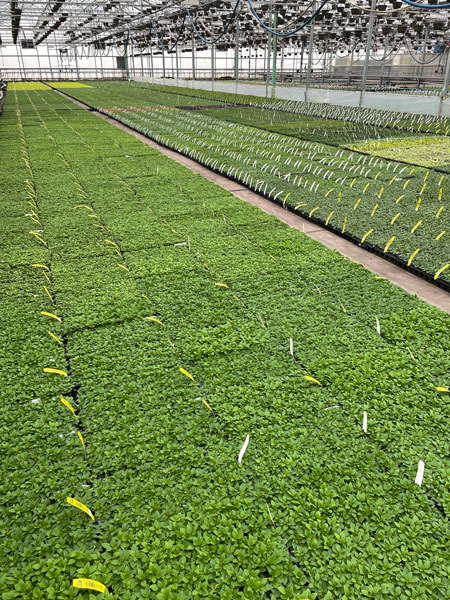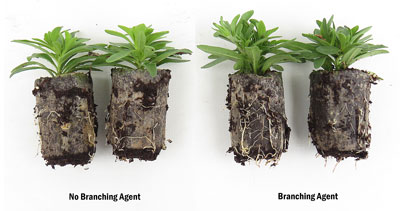12/1/2023
Yes, You Can Grow Calibrachoa Without Pinching by Hand!
Jennifer Zurko

Earlier this year, Mast Young Plants in Grand Rapids, Michigan, took on the challenge of growing their calibrachoa crop without any hand pinching. With disease issues becoming more common, it prompted them to figure out a way to decrease the risks, which included less manual “touches.”
“The main reason we looked at doing this was it seems that almost every year there is a virus that has infected a breeder’s stock, and the procedure of roguing out the product before it’s spread throughout the greenhouse is imperative,” explained Michael DeBerti, Senior Grower at Mast. “Many times we’ve found that we had the variety or varieties in question in the greenhouse for an uncomfortable time and the risk of cross contamination was fairly greater than we care to deal with.”
Pinching has been a common practice in calibrachoa production, but it also offers a higher chance of cross-contamination, spreading disease. And it’s pretty labor-intensive. So during the summer of 2022, Michael and his team started a no-pinch trial. They found that if you replaced pinching with a combination of one Florel PGR treatment or LED lighting, they could grow the same high-quality calibrachoa liner they’ve always offered.
“We are staffed fairly well, so we would hand pinch with a strict protocol on sanitation between varieties,” said Michael. “It’s still a labor cost, and with the couple hundred varieties we produce, it’s a task that cannot be taken lightly. So the thought was, what if we use chemical agents to be our ‘pincher?’”
The first phase of the trials showed that no treatment or just one Florel treatment at a low rate worked best for 80%-plus of the calibrachoa crops, including varieties from the Callie and Cabrio series.
For the more vigorous varieties, they used supplemental lighting under LEDs to decrease internode stretch. Since their adoption of LEDs, they’ve noticed that a blue spectrum keeps the fast-growing varieties from branching too much early in the production cycle. And if you keep them under LEDs for three weeks, you don’t have to apply PGRs at all.
“We found that, with the right timing, we could produce a great multi-branched liner,” said Michael. “The process was straightforward, and different rates and formulas were used to see if one out-performed the other.”
 For this coming spring, Michael said that there will be a few tweaks in production, which includes figuring out how each calibrachoa variety they grow reacts to different PGR rates.
For this coming spring, Michael said that there will be a few tweaks in production, which includes figuring out how each calibrachoa variety they grow reacts to different PGR rates.
“We are highlighting these varieties and adjusting our rates to tweak the PGR effect,” said Michael. “The amount these varieties can handle are somewhat small and our system of growing can earmark those quite easily.”
After seeing such positive results, Michael said they’re going to continue their plan of “chemically pinching” their calibrachoa crop and adjusting accordingly as they go along. If any PGR regime is required, it’s only during the young plant stage, so their customers can be assured that the plants will grow at their normal rate later in the finishing stages.
“We’ve had positive feedback from customers on this practice and this has inspired us to continue to do it,” he said. “The avoidance of the spread of viruses are a big concern with the grower customers.” GT